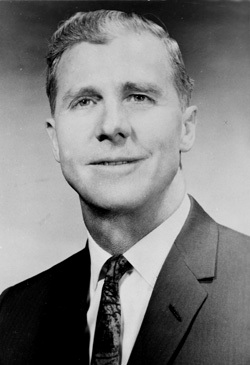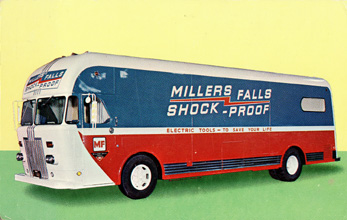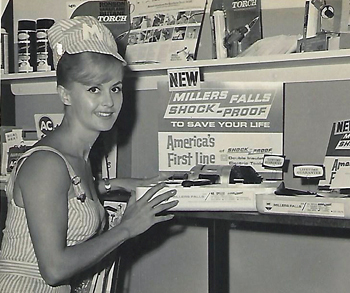Leonard C. Pratt
 Electrical engineer Leonard C. Pratt worked for the Millers Falls Company for nearly a quarter century and was responsible for the firm’s industry-leading advantage in double-insulated power tools. A 1934 graduate of Rensselaer Polytechnic Institute, Pratt worked at Forstmann Woolen Company, the Bendix & Singer Corporations, and Eastern Air Devices before taking a position as Assistant Chief Engineer at the Millers Falls Company in 1948. Working with Chief Engineer Whitfield Moretti, he was for the design and manufacturing setup of all electrical motors for the company’s power tool line.
Electrical engineer Leonard C. Pratt worked for the Millers Falls Company for nearly a quarter century and was responsible for the firm’s industry-leading advantage in double-insulated power tools. A 1934 graduate of Rensselaer Polytechnic Institute, Pratt worked at Forstmann Woolen Company, the Bendix & Singer Corporations, and Eastern Air Devices before taking a position as Assistant Chief Engineer at the Millers Falls Company in 1948. Working with Chief Engineer Whitfield Moretti, he was for the design and manufacturing setup of all electrical motors for the company’s power tool line.
The shock-proof tools
In the late 1950s, Whitfield Moretti sent Leonard Pratt to Europe to study the advanced power tool safety features that had been developed there. Pratt returned to the United States satisfied that continental techniques for insulating the user from the electrical components of a tool could be adapted for domestic use. Convinced by his report, Moretti worked for approval to develop the idea, a decision that eventually went all the way to the company’s board of directors. The first shock-proof tool, the No. 1144 Safe-T-Drill, was released in 1960. Not only did it protect a user who had thoughtlessly removed the cord’s grounding prong, it protected against problems due to cord wear and was safer than a conventionally grounded tool if used in damp conditions. Developed by Leonard Pratt and featuring a nylon casing created by noted industrial designer L. Garth Huxtable, the drill became a marketplace success.
The double-insulated No. 1144 was a light-weight tool intended for casual use. The engineering problems involved in insulating heavy duty, professional-grade tools were far more complex. Faster operating speeds and tougher use increased friction and operating temperatures and required the use of advanced ceramic and thermoplastic insulating materials. It took Leonard Pratt and his team three more years to bring out the company’s first double-insulated, heavy duty tools. By 1965, they had increased the number of double-insulated professional tools to forty-two; by 1968, the number was 120. Pratt’s shock-proof power tools sold well and, as much as anything, were responsible for keeping the Millers Falls Company solvent during the 1960s.
 An interesting sidebar in the promotion of the “shock proof” tools was the Millers Falls Shock-Mobile. A traveling information center intended to promote the company’s power tools, the Shock-Mobile was fitted with tool displays and could comfortably seat eighteen visitors. Equipped with a movie projector and sound system, visitors to the vehicle were treated to a film on the safe use of power tools. It is unlikely that the film, “A Split Second from Disaster,” lived up to the dramatic promise implied by its title.
An interesting sidebar in the promotion of the “shock proof” tools was the Millers Falls Shock-Mobile. A traveling information center intended to promote the company’s power tools, the Shock-Mobile was fitted with tool displays and could comfortably seat eighteen visitors. Equipped with a movie projector and sound system, visitors to the vehicle were treated to a film on the safe use of power tools. It is unlikely that the film, “A Split Second from Disaster,” lived up to the dramatic promise implied by its title.
Later career
The success of Pratt’s power tools did not go unnoticed. In 1962, he replaced an aging Whit Moretti as Chief Engineer of the Power Tool Division. Moretti, nearing retirement, became Director of Engineering. Four years later, Pratt followed in his footsteps when company president Otis E. Brown appointed him Vice-President and Director of Engineering. Pratt held his position during some of the most difficult years in the company’s history. Otis Brown’s successor, Regis Garvey, was determined to bring the then-struggling company to profitability and did so by means of a draconian downsizing of the product line, facilities and staff. Pratt’s engineering department was reduced from almost fifty workers to five and finally eliminated in 1973 when the development of new tools ceased.
 When Leonard Pratt’s twenty-five relationship with the Millers Falls Company ended, the company lost a highly regarded engineer and leading figure in the area of power tool safety. A member of the Institute of Electrical and Electronic Engineers for nearly four decades, Pratt had been chairman of the Power Tool Institute Engineering Committee, had worked on the standard for electric tool testing for Underwriters Laboratories, and had helped to develop the National Electric Code requirements for grounding electrical products. He estimated that his initial work on double-insulated tools gave the Millers Falls Company a five-year lead over its competitors Stanley and Black & Decker—a situation so disturbing to the rival firms that their representatives are reported to have sandbagged the development of new safety standards to allow their engineering departments time to catch up.
When Leonard Pratt’s twenty-five relationship with the Millers Falls Company ended, the company lost a highly regarded engineer and leading figure in the area of power tool safety. A member of the Institute of Electrical and Electronic Engineers for nearly four decades, Pratt had been chairman of the Power Tool Institute Engineering Committee, had worked on the standard for electric tool testing for Underwriters Laboratories, and had helped to develop the National Electric Code requirements for grounding electrical products. He estimated that his initial work on double-insulated tools gave the Millers Falls Company a five-year lead over its competitors Stanley and Black & Decker—a situation so disturbing to the rival firms that their representatives are reported to have sandbagged the development of new safety standards to allow their engineering departments time to catch up.
After leaving the Millers Falls Company, Leonard Pratt went on to establish a successful consulting business and worked with such electric tool companies as AEG, Black & Decker, Milwaukee, and Skil. An authority on electric tool insulation and grounding, he was called to serve as an expert witness by both plaintiffs and defendants in lawsuits related to power tool safety.
Leonard Pratt died in Englewood, Colorado on June 28, 2002, from injuries sustained in an automobile accident. He was 89 years old.
Patents
| Patent Number | Date | Description |
|---|---|---|
| 2,343,546 | March 7, 1944 | brush assembly for dynamo electric machines (with H. Fuge) |
| 2,350,968 | June 6, 1944 | brush assembly for dynamo electric machines (with H. Hamilton & A. Skrobisch) |
| 2,411,684 | November 26, 1946 | dynamo electric machine assembly |
| 2,693,541 | November 2, 1954 | improved brush holder for electric drill motors |
| 2,718,403 | September 20, 1955 | safety ski binding |
| 209,475 (Australia) | July 1956 | increased cutting speed in jig saw tool (with Whitfield Moretti) |
| 2,808,082 | October 1, 1957 | increased cutting speed in jig saw tool (with Whitfield Moretti) |
| 2,867,251 | January 1959 | improved depth adjustment mechanism in electric routers (with Whitfield Moretti) |
| 3,121,813 | February 18, 1964 | electric power unit for double insulated tools (with J. Raymond) |
| 3,344,291 | September 26, 1967 | construction system for double insulated, portable electric drills |
| 413,272 (Canada) | November 1968 | construction system for double insulated, portable electric drills |
| 3,440,465 | April 22, 1969 | reversing mechanism for double insulated motors (with J. Provost & J. DeCarteret) |
| 3,471,731 | October 7, 1969 | method of cushioning commutator leads in armatures |
Illustration credits
- Portrait: Millers Falls Company. News Release no. 50, June 6, 1966. (courtesy of Robert L. Pratt)
- Shock-Mobile: Postcard. Millers Falls Company, 1965.
- Woman with Shock Proof tools: private collection.
References
Sources for Leonard Pratt information:
- “MF Co. Brought Shock-Proof Tools to U.S.” In: A Century of Experience: Millers Falls Company. Greenfield, Mass.: Greenfield Record, Gazette and Courier, August 13, 1968.
- Pratt, Leonard C. Curriculum Vitae, ca. 1978. (courtesy of Robert L. Pratt).
- Telephone interview with Robert L. Pratt, September 14, 2008.